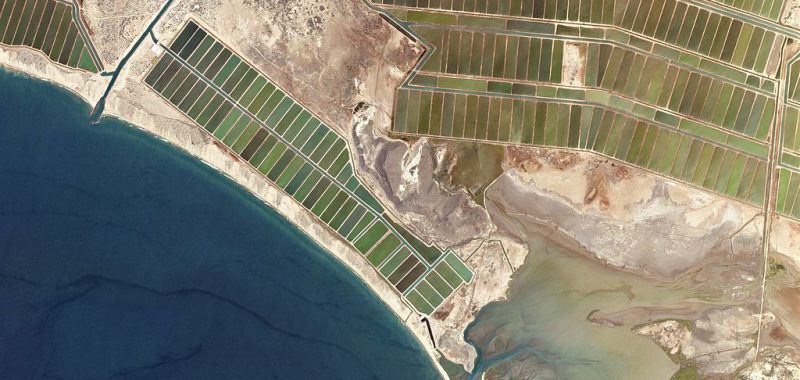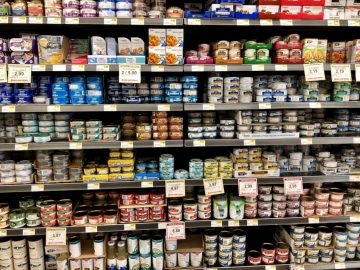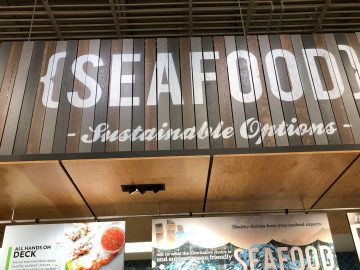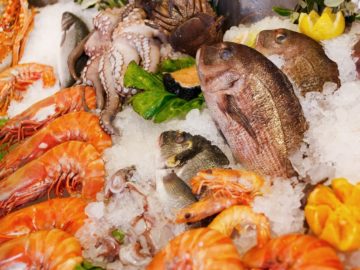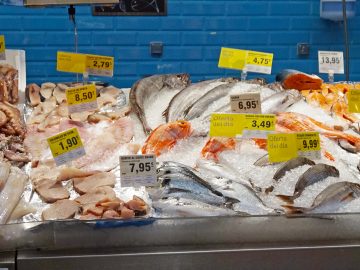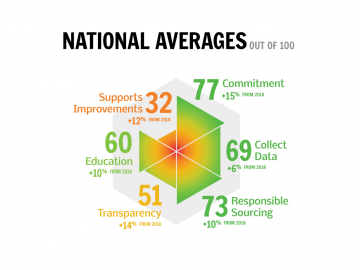Retailers are doing more to improve the sustainability of the worst offenders in the Canadian marketplace, but it’s not enough.
At the start of July, SeaChoice released our first annual update to Seafood Progress – an online resource that assesses and compares major Canadian food retailers’ sustainable seafood commitments and what they are doing to achieve them. Seafood Progress has six steps that follow the framework produced by the Conservation Alliance for Seafood Solutions in their Common Vision for Sustainable Seafood. This post is the last in a series that looks at each of the six steps in detail, highlighting trends, shortcomings and leaders in action.
The previous five posts reviewed how retailers scored on their Commitments, Data Collection policies, Responsible Sourcing practices, Transparency and Education. This post looks at what actions retailers are taking to support improvements in fisheries and aquaculture production, with a focus on the high-volume commodities with big environmental and social risks.
In Step 6, retailers are awarded points if they are engaging in actions to improve the production of Atlantic salmon that is farmed in Atlantic Canada, Western Canada, or internationally; farmed, imported shrimps and prawns; and/or skipjack tuna. Seafood Progress narrows in on these commodities because each is sold in high volumes in Canadian retail stores and the majority of production is Not Recommended by the Ocean Wise Seafood Program.
Examples of actions that have the potential to directly affect the supply chain include outreach to policy or decision-makers, pre-competitive collaboration with other seafood companies, and working directly with suppliers or producers. Actions retailers can take that send indirect market signals include not advertising unsustainable versions of a commodity, preferentially sourcing eco-certified or eco-labelled products, and preferentially sourcing products with high levels of social responsibility and traceability.
Most retailers are doing one or two actions per commodity, but some are doing many more – for example Loblaw, which is engaged in five different types of action to support improvement in farmed Atlantic salmon. These include working with the Aquaculture Stewardship Council (ASC) and Best Aquaculture Practices (BAP) certification programs on standard development and supply chain expansion, aiming to source farmed salmon from closed containment or organic certified open-water net pens, preferentially sourcing ASC certified salmon for its private label products, and only sourcing from suppliers that meet Loblaw’s Ethical Sourcing Policy and traceability requirements.
Alternatively, retailers can get full points if all the products sold in that commodity category are sustainably produced. SeaChoice considers products sustainably produced if they are eco-certified by the Marine Stewardship Council (MSC) or ASC (or, for shrimps and prawns, BAP 2-star or more), Recommended by Ocean Wise and/or ranked Best Choice by Seafood Watch. So, for example, Save-On-Foods scored 100 for KPI 6.1 because all its farmed salmon products are ASC certified. Retailers can also get full points if they refrain from selling the commodity altogether, for example, Buy-Low Foods scored 100 for KPI 6.1 because it doesn’t sell any farmed Atlantic salmon.
Retailers are doing the least to support improvements in the production of skipjack tuna (possibly because so few of their commitments include canned seafood in their policies). For example, three retailers are not engaged in any actions to support improvement of skipjack tuna and three are doing only one action. But some retailers are showing leadership on this issue. SeaChoice commends Walmart Canada for engaging in pre-competitive collaboration through the Retailer Canned Tuna Forum and the Seafood Task Force Tuna Sub-group, working directly with suppliers to switch to pole-and-line gear or free-school seining, and preferentially sourcing MSC certified tuna as part of its 2025 sustainable seafood commitment.
This step is about encouraging retailers to be part of the solution – to be active in improving the sustainability of the seafood they sell, beyond the more usual top-down pressure on their suppliers (although communicating their expectations and desires is important). And while the national average for this step increased by 13 points this year, despite two additional potential actions being added to the KPI scoring which meant that each individual action was worth fewer points, Step 6 continued to be the lowest scoring step in Seafood Progress. SeaChoice strongly encourages retailers – especially the eight profiled that scored under 50 on this step – to look at their workplans for the next year and see what else they could do.
Many of the actions in this step aim to increase the volume of sustainable seafood in Canada, which will be great for Canadian consumers. But some of the actions, like supporting producers to undertake improvements or advocating for better governmental regulation of the industry, also aim to ensure the costs and benefits of sustainable seafood are shared equitably across all actors in the supply chain. Producers need to be adequately rewarded, or at least compensated, if they are going to invest in practices that are more sustainable and responsible.
Producing seafood that is environmentally sustainable and socially responsible is clearly the right thing to do, but we need to make sure that all actors are justly compensated and that businesses are profitable over the long term. Otherwise, there’s very little incentive to make that extra effort to truly protect the natural resources that underpin seafood production, or the well-being of the people who get seafood from net or farm to plate. In other words, environmentally and socially sustainable seafood needs to be financially sustainable, as well.
We hope that you have enjoyed our series on the latest results from Seafood Progress. Please let your retailer know what they are doing right and where they can do better. You can take to social media, using the twitter buttons on their main profile page. Alternatively, next time you are in store, you can ask to speak to their seafood or customer service staff. At the end of the day your retailer wants to do right by you – so let them know sustainable seafood matters to you and it will continue to matter to them!
Others in this series:
